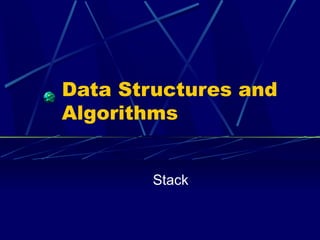
Data Structure Lecture 2
- 1. Data Structures and Algorithms Stack
- 2. Data Structures Linear: One to One Relationship Static and Dynamic Non linear Oneto Many Many to Many We will first cover Linear DSs
- 3. Stack A stack is used to store elements where the Last element In is the First one Out (LIFO). A common model of a stack is a plate or coin stacker. Plates are "pushed" onto to the top and “pooped” off the top.
- 4. Stack
- 5. Stack New elements are added or pushed onto the top of the stack. The first element to be removed or popped is taken from the top - the last one in.
- 6. Stack
- 7. Stack Operations A stack is generally implemented with only two principle operations Push adds an item to a stack Pop extracts the most recently pushed item from the stack Other methods such as Top returns the item at the top without removing it Isempty determines whether the stack has anything in it
- 8. Stack Implementation Static Implementation (Using arrays) Dynamic Implementation (Using dynamic lists)
- 9. Stack Implementation Using Arrays For the static implementation of stack an array will be used. This array will hold the stack elements. The top of a stack is represented by an integer type variable which contains the index of an array containing top element of a stack.
- 10. Stack Implementation Using Arrays 4 4 4 4 4 top 4 5 3 3 3 3 top 3 4 3 4 2 2 2 top 2 9 2 9 2 9 Push 8 Push 7 Push 9 Push 4 Push 5 1 1 top1 8 1 8 1 8 1 8 0 top 0 7 0 7 0 7 0 7 0 7 Empty stack top = StackSize – 1, StackSize = 5 Stack is full, top = -1 We can’t push more elements.
- 11. Stack Implementation Using Arrays push(element) { if (top == StackSize – 1) cout<<“stack is full”; else Stack[++top] = element; }
- 12. Stack Implementation Using Arrays 4 top 4 5 4 4 4 4 3 4 top 3 4 3 3 3 3 2 9 2 9 top 2 9 2 2 2 Pop Pop Pop Pop Pop 1 8 1 8 1 8 1 top1 8 1 0 7 0 7 0 7 0 0 7 top 0 7 Empty stack top = StackSize – 1, top = -1 Stack is full, We can’t pop mpre We can’t push more elements. elements
- 13. Stack Implementation Using Arrays pop() { if (top == –1) cout<<“stack is empty”; else return Stack[top--]; }
- 14. Stack Implementation Using Arrays topElement() //returns the top element of stack //without removing it. { if (top == –1) cout<<“stack is empty”; else return Stack[top]; }
- 15. Stack Implementation Using Arrays isEmpty() //checks stack is empty or not { if (top == –1) return true else return false }
- 16. Stack Implementation Using Arrays template <class Element_Type> class Stack { private: /* This variable is used to indicate stack is full or not*/ unsigned int Full_Stack; /* This variable is used to indicate top of the stack */ int Top_of_Stack; /* This pointer points to the array which behaves as stack, the space for this array is allocated dynamically */ Element_Type *Stack_Array Continue on next slide…
- 17. Stack Implementation Using Arrays //This constructor creates a stack. Stack(unsigned int Max_Size) { Full_Stack = Max_Size; Top_of_Stack = -1; Stack_Array = new Element_Type[Max_Size]; } /* This Destructor frees the dynamically allocated space to the array */ ~Stack() { delete Stack_Array; } Continue on next slide…
- 18. Stack Implementation Using Arrays /*This function Return TRUE if the stack is full, FALSE otherwise.*/ bool Is_Full() { if (Top_of_Stack == Full_Stack-1) returns True; else returns False; } /*This function Return TRUE if the stack is empty, FALSE otherwise.*/ bool Is_Empty() { if(Top_of_Stack == -1) returns True; else returns False; Continue on next slide… }
- 19. Stack Implementation Using Arrays // If stack is not full then push an element x in it void Push(Element_Type x) { if(is_Full()) cout<<“stack is full”; else Stack_Array[++Top_of_Stack] = x; } //if Stack is not empty then pop an element form it Element_Type pop() { if(is_Empty()) cout<<“stack is empty”; else return Stack_Array[Top_of_Stack--]; } Continue on next slide…
- 20. Stack Implementation Using Arrays // This function makes the stack empty void Make_Empty() { Top_of_Stack = -1; } /* This function returns the top element of stack */ Element_Type Top() { if(is_Empty()) cout<<“stack is emepty”; else return Stack_Array[Top_of_Stack]; } };
- 21. Applications of Stack Reversing the string push each character on to a stack as it is read. When the line is finished, we then pop characters off the stack, and they will come off in the reverse order.
- 22. Applications of Stack Reversing the string void ReverseRead (void) { STACK<char> stack(256); //The stack stack is created and can //hold at most 256 elements of type char char item; cin>>item; while (!stack.is_Full() && item ! = “n”) { stack.Push (item); // push each character onto the stack cin>>item; } while(! stack.is_Empty() ) { item = stack.Pop (); //Pop an element from stack cout<<item; } }
